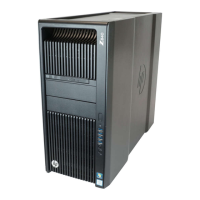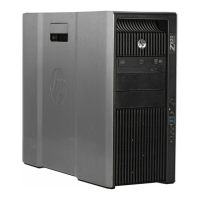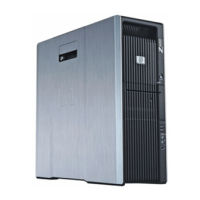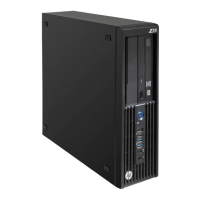10
Technical white paper | HP Z840 Workstation
Table 3: HP Z840 I/O slot recommended load order
Load
priority Card description
Load order (depending on slot availability)
Slot 0 Slot 1 Slot 2 Slot 3* Slot 4* Slot 5 Slot 6 Slot 7
CPU0 Mechanical
slot only
PCIe3 x4 PCIe3 x16 PCIe3 x16
CPU1 PCIe3 x8 PCIe3 x16 PCIe3 x8
Chipset PCIe2 x8 (4) PCIe2 x1
1 1st GPU Only
2 2nd GPU (requires
1125 W PSU)
Only
3 1st Graphics 1st 3rd 2nd
4 2nd Graphics 2nd 1st
5 3rd Graphics
(requires 2nd CPU)
2nd 1st
6 4th Graphics
(requires 2nd CPU)
Only
7 NIC - 10 Gb 6th 2nd 4th 3rd * 1st
8 Z Turbo Drive/PCIe
storage
6th 2nd 4th 3rd * 1st
9 8-port RAID LSI
9270-8i SAS 6 Gb/s
4th 1st 3rd 2nd 5th
10 Thunderbolt™ 2
3
Only
11 NIC < 10 Gb 1st 4th 2nd 5th 3rd 6th
12 Audio 1st 2nd 3rd
13 1394b Firewire x x x x x 2nd x 1st
14 eSATA (Cable)** 1st
15 MiniSAS-4x Cable
(PCI Bulkhead)**
1st
16 Serial Port
(cable)**
1st
* Only available with 2nd CPU.
** No electrical connection to PCI and PCIe slots, use any free mechanical slot location.
x Card is not supported in the slot.
Additional tips
• For applications doing direct bus Peer-to-Peer transfers between cards, load the corresponding cards in slots located
behind the CPU. For instance, load cards in slots 2, 4 and 5.
• For very high bandwidth applications in dual CPU systems, select CPU models with the highest QPI frequency (9.6 GT/s).
• Make sure all I/O cards are loaded in slots that have a PCI-Express Lane Width at least as wide as the card (see Table 3).
• For predictable latencies, try disabling NUMA (Non-Uniform Memory Access) mode (BIOS setup menu -> Advanced ->
Bus Options -> NUMA = Disabled).
• For cards that are latency sensitive, load these cards in CPU slots.
• Ensure Idle Power Savings BIOS setting is set to Normal (BIOS setup menu -> Power -> OS Power Management -> Idle
Power Savings = Normal).
• Use the latest BIOS version available on hp.com.
• Check for updates in the latest performance optimization white papers (link below).

